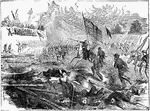The 1861-1865 Civil War Land Battles ClipArt gallery offers 270 illustrations of land battles that were fought between the Union and the Confederacy during the American Civil War.

Allatoona Pass
The Battle of Allatoona, also known as Allatoona Pass, was fought October 5, 1864, as part of the Franklin-Nashville…

Antietam
"The invasion of Maryland--General Meade's Army crossing the Antietam in pursuit of Lee, July 12th,…
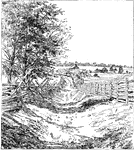
Sunken Road at Battle of Antietam
The Sunken Road at the Battle of Antietam. The Battle of Antietam, also known as the Battle of Sharpsburg,…
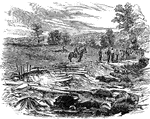
Sunken Road at Battle of Antietam
Scene at the Sunken Road at the Battle of Antietam. The Battle of Antietam, also known as the Battle…
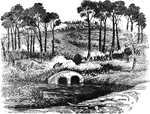
Battle of Antietam
"Battle of Antietam, Md. Burnside's division carrying the bridge over the Antietam Creek and storming…

Battle of Antietam
The Battle of Antietam (also known as the Battle of Sharpsburg, particularly in the South), fought on…

Battle of Antietam
Scene by rail-fence, Antietam after the Battle of Antietam, also known as the Battle of Sharpsburg.…

Battle of Antietam
The Battle of Antietam, also known as the Battle of Sharpsburg, was fought on September 17, 1862, near…

Battle of Antietam
"Battle of Antietam, Burnside's Division, left wing- brilliant and decisive bayonet charge of Hawkins's…

Battle of Antietam
"Battle of Antietam- the opening of the fight- Hooker's division fording the Great Antietam Creek to…

Battle of Antietam
"Battle of Antietam. The centre and right wing of General McClellan's Army, commanded by Generals Hooker,…

Battle of Antietam
"The battle of Antietam. The One Hundred and Thirtieth Pennsylvania Regiment of Volunteers burying the…

Battle of Antietam
"Battle of Antietam, Burnside's Division, left wing- brilliant and decisive bayonet charge of Hawkins's…

Battle of Antietam
"Battle of Antietam, Burnside's Division, left wing- brilliant and decisive bayonet charge of Hawkins's…
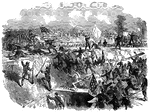
Arkansas Post
"The capture of Arkansas Post, Ark. General Stephen G. Burbridge, accompanied by his staff, planting…
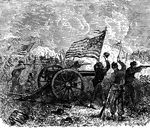
Battle of Atlanta
Showing the Battle for Atlanta, which Sherman won for the Union during the Civil War.
Siege of Atlanta
"The Siege of Atlanta, Ga.- Confederate attack on General Logan's Corps, July 28th, 1864. The assailants…

Battle of Baker's Creek
"Battle of Baker's Creek, May 16th, 1862- Defeat of the Confederates under Pemberton, by General Grant.…

Battle of Baton Rouge
The Battle of Baton Rouge, also known as Magnolia Cemetery, was a ground and naval battle in the Civil…

Artillery Battery
During early wars, like the Civil War, artillery battery was a term for a unit of guns or mortars used…

Battle of Fair Oaks
The Battle of Fair Oaks, also known as the Battle of Seven Pines or Fair Oaks Station was fought on…

Bealington
"Engagement at Bealington, Va., between Ohio and Indiana regiments and a detachment of Georgia troops.…

Battle of Belmont
"Battle of Belmont, Mo., opposite Columbus, Ky, November 7th, 1861- Federal forces commanded by U. S.…

Battle of Bentonville
"The Battle of Bentonville, N. C.- Major General Mower, commanding First Division, Seventeenth Corps,…

Battle at Big Black River
The Battle of Big Black River Bridge, or Big Black, fought May 17, 1863, was part of the Vicksburg Campaign…

View on the Big Black River
The Battle of Big Black River Bridge, or Big Black, fought May 17, 1863, was part of the Vicksburg Campaign…

Blue Ridge Pass
"The victory at Blue Ridge Pass, Sunday, September 14th, 1862- infantry charge, and rout of the Confederates.…

Battle of Blue Ridge Pass
"Battle of Blue Ridge Pass, Sunday, September 14th, 1862- the first Federal victory in Maryland. On…

General Lyon's March to Booneville
The Battle of Booneville was a skirmish of the American Civil War, occurring on June 17, 1861, in Cooper…

Battle of Bull Run
The First Battle of Bull Run, also known as the First Battle of Manassas, was the first major land battle…

Commencement of Bull Run
"The Confederate forces under General Jackson advancing upon the Rapphannock Station at the river. Federal…

First Battle of Bull Run
The First Battle of Bull Run is also known as the First Battle of Manassas and was the first major land…

Second Battle of Bull Run
"Second battle of Bull Run, fought Saturday, August 30th, 1862, between the Federal forces commanded…

Battle of Carrick's Ford
"Battle of Carrick's Ford, between the troops of General McClellan's command, under General Morris,…

View at Cedar Creek Battle-ground
The Battle of Cedar Creek, or The Battle of Belle Grove, October 19, 1864, was one of the final, and…

Battle of Cedar Mountain
"Battle of Cedar Mountain, fought Saturday, August 9th, 1862, between the Federal troops commanded by…

Battle of Cedar Mountain
"Gordon's and Crawford's Brigades driving the Confederate forces from the woods at the Battle of Cedar…

Battle of Cedar Mountain
"The Confederate batteries shelling the Federal position on the night of the Battle of Cedar Mountain,…

Borough of Chambersburg
Burning of the engine-house at Chambersburg. The borough was the only major northern community burnt…
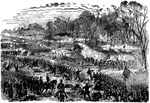
Battle of Champion Hills
"Battle of Champion Hills, May 16th, 1863- the formidable position of General Pemberton carried by Generals…
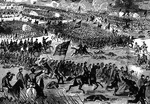
Battle of Champion Hills
"Battle of Champion Hills, May 16th, 1863- the formidable position of General Pemberton carried by Generals…

Battle of Champion Hills
"Battle of Champion Hills, May 16th, 1863- the formidable position of General Pemberton carried by Generals…
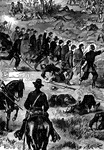
Battle of Champion Hills
"Battle of Champion Hills, May 16th, 1863- the formidable position of General Pemberton carried by Generals…

Battle of Chancellorsville
"Battle of Chancellorsville, Va., Friday, May 1st, 1863. We give a fine sketch of the point where the…

Battle of Chancellorsville
"Battle of Chancellorsville, Va. Attack on General Sedgwick's Corps. on Monday, May 4th, 1863, at 5…
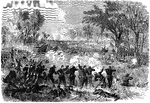
Battle of Chancellorsville
"Battle of Chancellorsville, Sunday, May 3rd, 1863. General Hooker repulsing the attack of the enemy.…

Battle of Chancellorsville
"Battle of Chancellorsville, Sunday, May 3rd, 1863. General Hooker repulsing the attack of the enemy.…
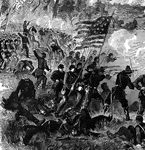
Battle of Chancellorsville
"Battle of Chancellorsville, Sunday, May 3rd, 1863. General Hooker repulsing the attack of the enemy.…
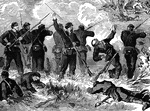
Battle of Chancellorsville
"Battle of Chancellorsville, Sunday, May 3rd, 1863. General Hooker repulsing the attack of the enemy.…

March to Chancellorsville
Soldiers marching to Chancellorsville Virginia. The Battle of Chancellorsville was a seven day battle…

Final Charge at Gettysburg
The final charge of the Battle of Gettysburg. Both the Confederates and the Union lost thousands of…

Battle of Charles City
"Battle of Charles City Road- charge of the Jersey Brigade- the first New Jersey brigade, General Tayler,…

Charleston
"Seacoast operations against Charleston- brilliant dash and capture of Confederate rifle pits and prisoners…
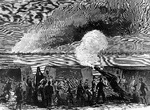
Siege of Charleston
"Siege of Charleston- the doomed city fired by Gillmore's explosive shells from Fort Putnam, January…

Valley of Chickahominy
"Valley of the Chickahominy, looking southeast from the vicinity of Mechanicsville, the scene of the…
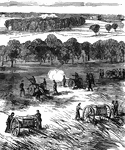
Valley of Chickahominy
"Valley of the Chickahominy, looking southeast from the vicinity of Mechanicsville, the scene of the…
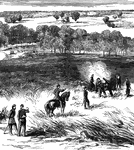
Valley of Chickahominy
"Valley of the Chickahominy, looking southeast from the vicinity of Mechanicsville, the scene of the…
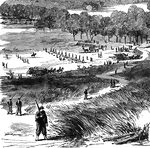
Valley of Chickahominy
"Valley of the Chickahominy, looking southeast from the vicinity of Mechanicsville, the scene of the…

Battle of Chickamauga
The Battle of Chickamauga, fought September 18-20, 1863, marked the end of a Union offensive in south-central…
